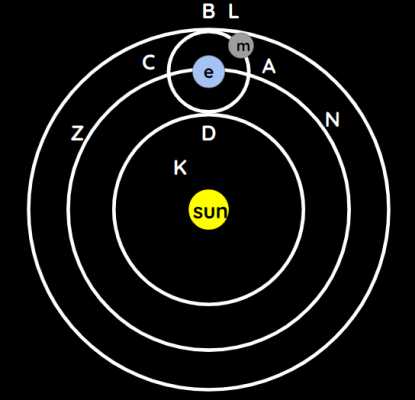The Motion of the Moon
Table of Contents
149. Why the Moon revolves around the Earth.
The Moon revolves around the Sun and the Earth at the same time.
This is because the Moon moves towards the Earth before the Earth orbits the Sun.
The Earth goes around the Sun S in the circle NeZ. It is carried from N, through e towards Z`.

Superphysics Note
The air-aethers at A move faster than the planet e. They push e towards Z.
e in return pushes the air-aethers towards B instead of towards D. This is because the air-aethers are inclined to continue their motion in a straight line. And so they must go outside of the orbit ACZN which they create, rather than towards the sun.
Passing from A to B, they force planet e to turn with them around its center. This then lets them go from B to C, then to D and to A.
150. Why the Earth rotates around its axis.
There are various reasons why the Earth rotates around its own axis. It was previously a star, located at the center of some vortex, where it rotated.
It still has similar motions, impelled by the fire-aether gathered in its center.
151. Why the Moon moves faster than the Earth
The Earth revolves about its axis nearly 30 times, while the Moon only once traverses the circumference of the circle ABCD which is around 60 times larger than the Earth’s orbit.
This is why the Moon moves twice as fast as the Earth.
Both are acted on by the same air-aether which moves not less quickly near the Earth than near the Moon.
And so there is no other cause for the faster speed of the Moon than that it is smaller than the Earth.
152. Why the same side of the Moon always faces the Earth.
The same part of the Moon always faces the Earth, or at least does not deflect much from it.
This happens because another part of it is somewhat denser.
Therefore, in circling around it, must cover a larger orbit; as in the example noted a little earlier about Comets.
The side facing Earth has countless inequalities like mountains and valleys as seen from telescopes.
These are evidences for its lesser solidity.
The cause of this lesser solidity may be that another side of it, which never comes into our view, only receives the direct light from the Sun; whereas the facing side also receives that which is reflected from the Earth.
153. Why the Moon moves faster and deviates less from its mean motion in conjunctions than in quadratures. Why its sky is not round.
The Moon seems to move somewhat faster and deviate less from its course in all directions when it is full or new, than when it appears only half, or when it is towards parts of the sky B or D, than when it is towards A or C.

This is because the air-aether in the space ABCD are different in size and motion from those which are:
- below D towards K
- above B towards L
But those which are towards N and Z are similar. They spread more freely towards A and C than towards B and D.
This is why the orbit ABCD is not a perfect circle, but rather an ellipse.
The air-aether is carried more slowly between C and A than between B and D.
The Moon is carried by this air-aether. This is why it approaches closer to the Earth if it is moving towards it, and be more distant if it is moving away, when it happens to be towards A or C, than when it is towards B or D.